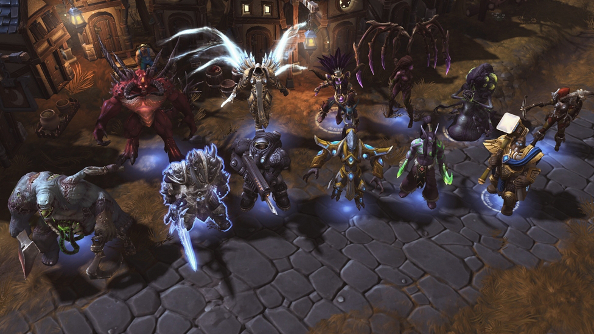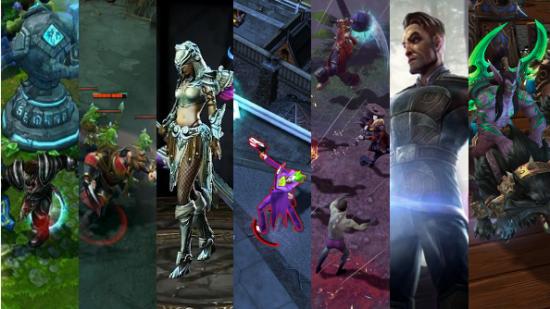“We’re making a MOBA, an ARTS, a ZOMBA, a MOTA, a MOBAFPS,” is something we’re hearing a lot of these days. No IP or theme is safe. There’s one for Lord of the Rings, one with zombies and another with gods. Even EA is getting in on the action, and Blizzard, too. The heavens have opened up and we’re being drowned in MOBAs.
Dear industry: please, slow down.
I feel uncomfortable, sitting here and advocating the temporary cessation of a particular genre. But MOBAs are going through a cycle not unlike MMOs, just accelerated.

It led to all the creativity and possibilities inherent in the original concept of an MMO being set aside for a simple list of features that every game must have. And It’s happening at a quicker pace with MOBAs because it’s not a genre that was exactly filled with possibilities to begin with. These aren’t sandboxes or open worlds; they are built – almost all of them – on the same set of rules, with only a little bit of wiggle room between them.
In all fairness, developers have made the most of that wiggle room. Smite, for example, changes the perspective and puts the focus on action, while the upcoming Battleborn is a MOBAFPS and promises a co-op campaign.
But even when developers attempt something different, all it does is emphasize how similar all of these games can be. Temporary levels, lanes, creeps, bases and towers – the core of these titles tends to be identical, and they’re all feeding from the same trough, the same audience.

When you say you like RPGs, that doesn’t mean anything. You could love turn-based fantasy RPGs like Divinity: Original Sin, or maybe you prefer heavy clicking and looting romps like Diablo III, or maybe you only get joy out of MMORPGs like World of Warcraft. They’re all RPGs, but are only superficially similar.
MOBAs lack that diversity. They are generally tailored to one audience, the same audience, and are thus designed to fulfill a very specific set of needs. These games stick to tried and tested designs, while occasionally adding ancillary elements to set them apart from the competition.
Other niche genres – and MOBAs are definitely niche, even if they are big – don’t have the same costs that are involved in maintaining a MOBA, either. Constant patches, content updates, large customer support facilities, official tournaments – what once could have seemed like a cheap alternative to MMOs is no longer so. Even if development is cheaper, supporting them indefinitely is costly.

As game development becomes more expensive and competitive, developers become more desperate. With Steam sales and Humble Bundles meaning that people can pick up your game for 75 percent off, less than a year after launch, how the hell do you keep making money? The answer seems to be F2P games with microtransactions, and almost every single MOBA has gone down this route.
While straightforward purchases and subscriptions stay outside of games, microtransactions do not. It’s a business model that has to be built into the very fabric of the title. So all of these games are fighting for a few dollars here, a couple of pounds there, always upselling. They share mechanics and business models, and I just don’t see how there’s room for more of them, leaving their players empty handed and less likely to invest in the genre again.
And there’s the eSports thing. Could you imagine a world where every single year, a half-dozen new versions of football appeared? I’m not talking about new sports or dramatic variations like NFL, football and rugby, but small twists on exactly the same sport.

Cliff Bleszinski, who isn’t making a MOBA (although, being pedantic for a moment, BlueStreak certainly fits the acronym), made a very common sense remark in a recent AMA when he was asked about BlueStreak potentially being an eSport. “[Y]ou can’t just make an Esport. It’s like trying to force a meme, it doesn’t work that way,” Bleszinski said. “You make an AIRTIGHT game first with a ROCK SOLID community and maybe, just maybe, you can make that leap.”
But making a successful eSports game has become such a tantalising prospect for MOBA developers that they’re forcing them in that direction before the game’s even launched. There are eSports tournaments for games that haven’t even launched. It’s like kicking off the World Cup before the grass has been laid or the stadium built.
It’s only going to become harder for future MOBAs to make waves. That’s not going to stop the torrent, though. With Valve and Riot’s success, the genre is only going to get more bloated until it buckles under its own weight. There’s something cynical about this recent explosion. I don’t doubt for a moment that a lot of developers simply love MOBAs and want to make one themselves. But would they be doing that if it wasn’t for the ability for League of Legends to fill up convention centres and auditoriums? Would EA be publishing one?

There are all these boxes that MOBAs need to tick, and it threatens to limit creativity. But being creative in a genre dominated by two games that everyone has grown extremely comfortable with, that’s a risk as well.
If it keeps on going, the incessant spawning of new titles, diversification seems like the only option. But how will that work? How do you make something that’s still obviously a MOBA, but bring in new players who wouldn’t otherwise dabble in that genre. Change too many things and it might not be a MOBA; don’t change enough, and it will still be competing with the rest of them for the same audience.
I don’t see a good end to this. MOBAs are not a passing fad, but this trend of everyone and their mum making them isn’t doing the genre any favours. Dota 2 and LoL can weather the deluge, but can the same be said for the games just getting their footing? Probably not. Maintaining a stable player-base is absolutely the most important things to any multiplayer game, and unless we start cloning players, there are going to be some mighty empty servers.
